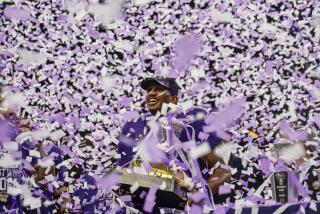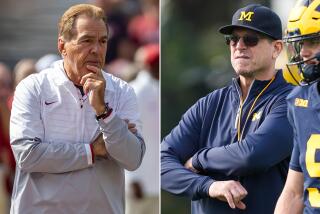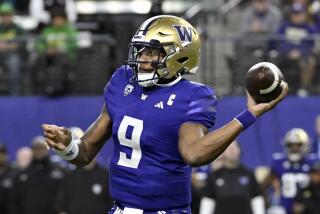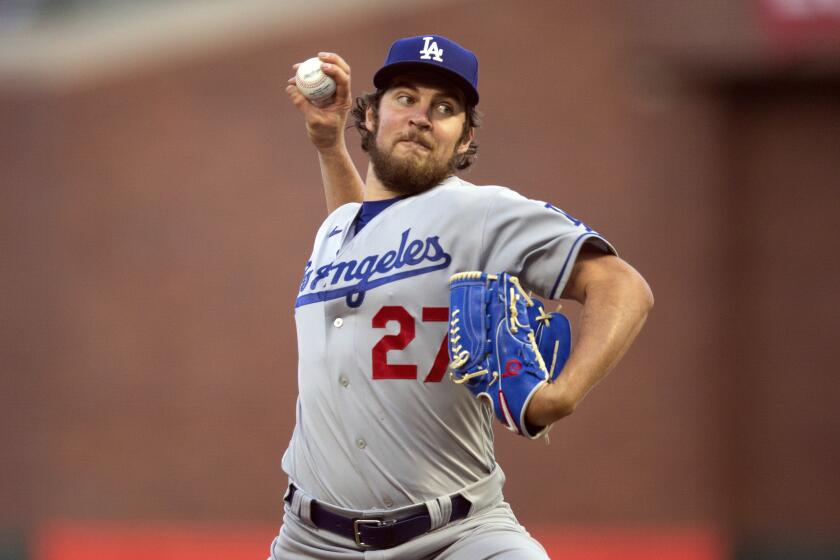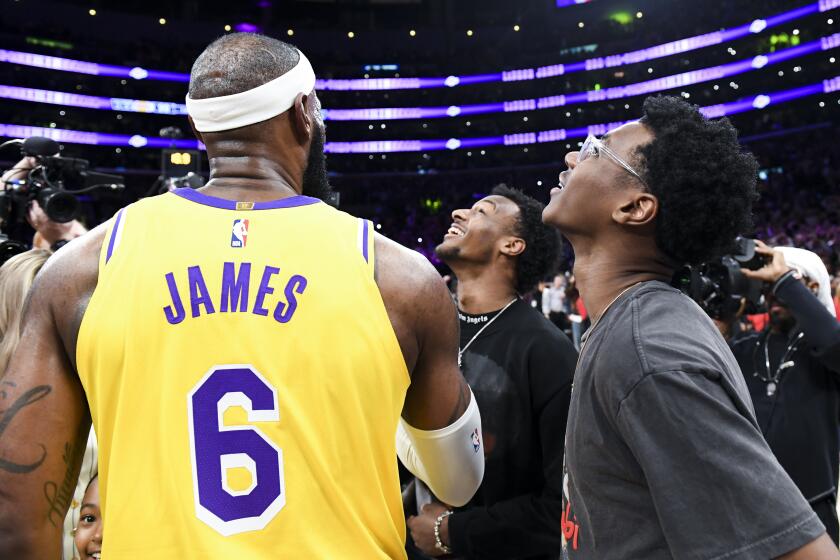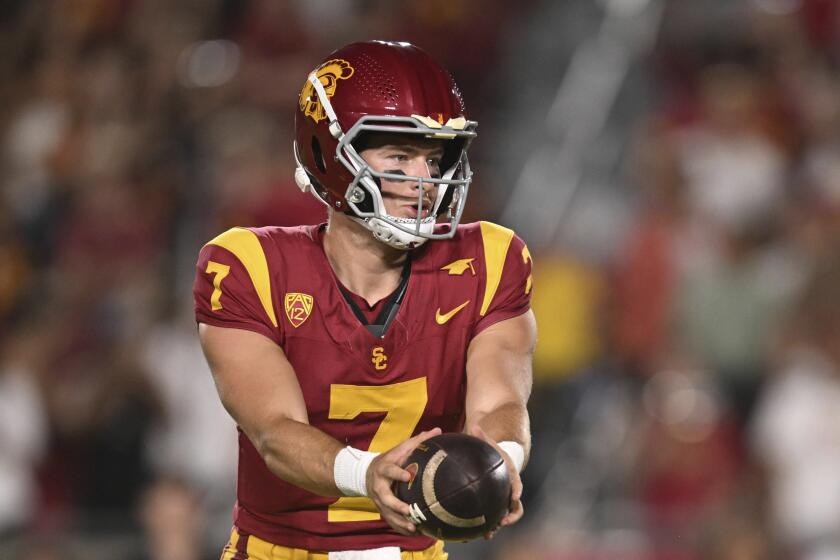Column: Oregon is No. 1 in The Times’ ‘Super 16’ countdown
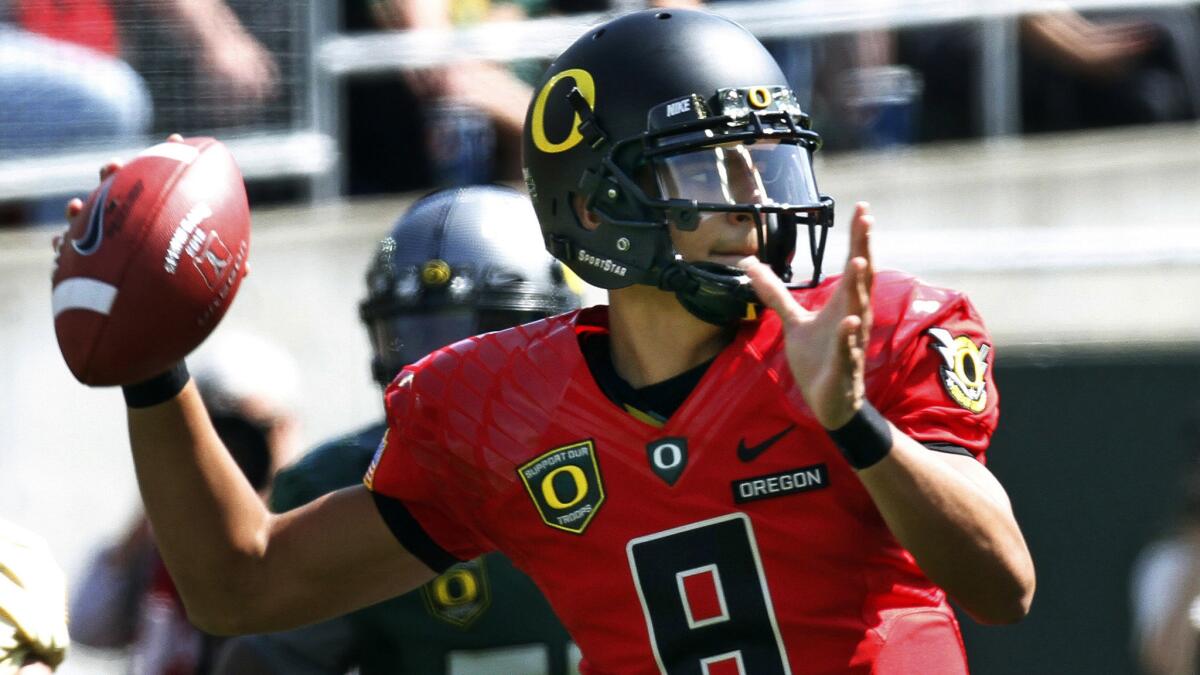
Acknowledging that college football’s new four-team playoff could someday inch toward a larger basketball-style tournament, we finish our ‘Super 16’ countdown, with No. 1 Oregon:
The race for championships, trophies and recruits will continue unabated, for years to come. However, the arms race in college football is over.
Oregon won, and everybody else is a guest cottage at Hearst Castle.
A jaw-dropping tour of the Ducks’ athletic facilities last Saturday left this visitor wondering how something so outrageously opulent could spring from a sleepy, rainy college town once known for joggers and granola bars.
How did college football get to this?
The new 145,000-square-foot, $68-million Hatfield-Dowlin Complex adjacent to Autzen Stadium is the capstone to Oregon’s stunning rise to a college football national brand.
Twenty years ago, Oregon football was thrilled just to lose a Rose Bowl game against Joe Paterno’s mighty Penn State team. The Ducks were a proud, isolated, self-deprecating lot fighting the good fight under the brow of Washington.
Oregon has gone from having a complex to having the complex.
Today, corporations from around the world, including European soccer franchises, visit Eugene and marvel at Oregon’s largesse.
Saturday’s tour was led by Craig Pintens, Oregon’s senior associate athletic director for marketing and public relations. It started beneath 12-foot doors opening to a three-story atrium and quickly led to a panorama of 55-inch televisions — 64 of them.
Players enter the building using biometric thumb prints.
The chairs in the main team meeting theater, with its perfect acoustics, are made of Ferrari leather. The wallpaper is real football pigskin. There is a Dr. Strangelove-like “war room” for coaches and another room — equipped with computer screens and a separate bathroom — for visiting NFL scouts.
The 25,000-square-foot weight room floor is made of Brazilian Ipi wood, so hard, Pintens says, you can’t drive a nail through it.
The player lounge is equipped with pillowy soft couches and foosball tables made in Barcelona. Meticulously hand-painted illustrations of Oregon players are pitted against players from opposing Pac-12 Conference schools. All wear Nike shoes, ignoring the fact that UCLA is sponsored by Adidas.
Players dress for practice in front of German-made lockers that cost $26,000 each.
“The air from the top sucks out all the sweat from your gloves, your helmet and your pads,” cornerback Ifo Ekpre-Olomu said of the in-locker ventilation system. “Just little things like that blow your mind every day.”
The room was designed to eliminate smells commonly associated with sweaty socks. “You could walk in this locker room and stay in there all day,” Ekpre-Olomu said.
The compound has its own barber shop, several nutrition bars and a state-of-the art hydro-therapy treatment center. Every Oregon player ever drafted in the NFL is represented in one room with a crystal duck.
The walls protecting the practice field are made of basalt lava.
No wonder Ekpre-Olomu, a projected first-round NFL pick, decided to come back for his senior season. “I can’t see any pro team having any better facilities,” he said.
You could argue this all borders on obscene. But in case you missed it, college football isn’t fair, and the NCAA can’t mandate level playing conditions. Oregon would say it is countering years of being disadvantaged by its remote proximity and limited access to the fertile recruiting grounds of population-rich Los Angeles.
It was dumb, blind, rich Duck luck that a former Oregon student, Phil Knight, created Nike. There are no rules preventing Knight and other wealthy donors from investing heavily in the Ducks’ cause.
“It’s been success, and, really, Nike,” Pintens said of Oregon football’s rise. “Let’s face it. Without them, we wouldn’t be here.”
Nike hasn’t been able to fix everything, though. For all the trinkets in Oregon’s toy room, one thing is missing: a national title in football.
Oregon has come excruciatingly close. The Ducks were No. 2 in the Associated Press media poll and national coaches poll in 2001, yet didn’t make the cut in the Bowl Championship Series standings. And Oregon looked like the best team in 2007 before star quarterback Dennis Dixon blew out a knee ligament.
Chip Kelly’s team lost the 2010 title on a last-second field goal by Auburn. Losses to Stanford the last two seasons have doomed Oregon’s title plans.
There is increasing pressure on the program, coaching staff and players to justify the investment.
“To be blessed to have all this stuff around us, we want to give back,” Ekpre-Olomu said. “We want to give back to Phil Knight, to give back to Nike, give back to all the donors that donated to the school and changed Oregon, really.”
This could be the season Oregon finally gets all its Ducks in a row.
Oregon received two big off-season gifts when star quarterback Marcus Mariota and Ekpre-Olomu spurned the NFL.
Mariota and Florida State’s Jameis Winston are the nation’s two best returning quarterbacks. Mariota might have won the Heisman Trophy last year if not for a late-season knee injury that slowed him in losses to Arizona and Stanford.
Mariota operates behind a veteran offensive line and has blazing speed on the fringes. Oregon loses the elusive De’Anthony Thomas but welcomes receiver Devon Allen, who won the NCAA outdoor 110-meter high hurdles title last spring in a school-record time of 13.16 seconds.
The defense, anchored by Ekpre-Olomu, needs only to allow fewer points than Oregon’s offense can score.
The prove-it part of the schedule comes early, Sept. 6, when Oregon plays host to defending Rose Bowl champion Michigan State. The Ducks can help erase their “soft” national reputation with a win against the team that stonewalled Stanford in the Rose Bowl.
In the new, four-team national playoff, Oregon might even be able to survive a regular-season loss so long as it rebounds to win the Pac-12 title.
This would seem the right year for the Ducks to address their Stanford problem, as the Cardinal must regroup from heavy personnel losses. Oregon gets Stanford at home on Nov. 1.
It is incredible, really, that Oregon has become what it is without winning a title. The Ducks’ rise has been marked by an extraordinary confluence of motivation, innovation, timing, luck, perspiration and marketing moxie.
The motivational turning point has been tracked back to an embarrassing 1996 Cotton Bowl defeat to Rick Neuheisel’s Colorado team that spurred Knight into action.
Oregon then took a leap in 1998 by unveiling new uniforms in various combinations of colors and contrasts.
Jim Bartko, the athletic department’s director of development, recalls that the uniforms weren’t instantly popular.
“Half the fans hated it, half the fans loved it,” Bartko said. “But we had success and then they all liked it.”
In 2001, Oregon audaciously promoted quarterback Joey Harrington as “Joey Heisman” with a giant billboard in New York’s Times Square.
The campaign had a fair share of critics but may have been the best $250,000 Oregon ever spent. Harrington didn’t win the Heisman, finishing fourth, but he justified the campaign with an 11-1 season capped by a Fiesta Bowl win over Colorado.
“We took a chance with that billboard,” Bartko said. “But Joey was the best player you could ever have. And we won.”
David Williford, the school’s longtime football communications director, says Oregon’s rise might have never happened had Harrington not rallied his team to a win over Wisconsin in the 2001 opener.
“That was the key,” Williford said. “You either hit a home run or strike out. There’s nothing in between.”
Coach Mike Bellotti kept football at a high level during the 2000s and greatly contributed to Oregon’s next craze phase when, in 2007, he hired Kelly as offensive coordinator. Bellotti saw the spread-option offense as the future but wasn’t comfortable implementing it himself. He ultimately entrusted Kelly, a wisecracking unknown from New Hampshire, who started an up-tempo revolution.
Everything morphed together for Oregon — the tempo, the uniforms — at a time when college football popularity was growing exponentially.
Ekpre-Olomu, who grew up in the dairy town of Chino and starred at Chino Hills High, became mesmerized by Oregon as a seventh-grader. “It was a video game with Joey Harrington on the cover,” Ekpre-Olomu said.
Oregon has largely succeeded with its strategy of becoming everybody’s second-favorite team.
“College football has been based on tradition,” Ekpre-Olomu said. “Oregon is trying to change tradition through innovation. Most teams try to keep the tradition they started. We start something the year before and, if we don’t like it, we change it.”
Oregon football is a modern-day excess story that is missing only the final crowning component.
Success ultimately is determined by championships.
Is this, finally, the year a huge investment pays off?
Here’s the complete ‘Super 16’ countdown: 16. Notre Dame, 15. Mississippi, 14. Stanford, 13. Louisiana State, 12. Michigan State, 11. USC, 10. Baylor, 9. Georgia, 8. South Carolina, 7. Ohio State, 6. Auburn, 5. UCLA, 4. Oklahoma, 3. Alabama, 2. Florida State, 1. Oregon
More to Read
Get our high school sports newsletter
Prep Rally is devoted to the SoCal high school sports experience, bringing you scores, stories and a behind-the-scenes look at what makes prep sports so popular.
You may occasionally receive promotional content from the Los Angeles Times.
